Contents
:
:
:
:
:
:
:
Figures
Tables

Blockchain Technology and Applications
Blockchain is an emerging platform for developing decentralized applications and data storage, over and beyond its role as a platform for cryptocurrencies. This reference text provides a comprehensive discussion on blockchain technology from research and application perspective.
Discusses different approaches for building distributed applications (DAPPS).
Provides detailed listing and discussion of blockchain technology applications in solving real-life problems.
Covers proof of work (PoW) based blockchain consensus, and proof of stake (PoS) based blockchain consensus.
Discusses blockchain algorithms including practical byzantine fault tolerance (PBFT) and simplified byzantine fault tolerance (SBFT).
It comprehensively covers important topics including blockchain consensus algorithms, Ethereum, Hyperledger, blockchain scalability, smart contracts with solidity, ERC20 standards, building DApp with Golang, building DApp using Hyperledger, building PoCs with Hyperledger fabric, blockchain as a server, blockchain security and privacy.
The text will serve as a useful text for senior undergraduate and graduate students in interdisciplinary areas including electronics and communications engineering, electrical engineering, computer science, and information technology.
First edition published 2023
by CRC Press
6000 Broken Sound Parkway NW, Suite 300, Boca Raton, FL 33487-2742
and by CRC Press
4 Park Square, Milton Park, Abingdon, Oxon, OX14 4RN
CRC Press is an imprint of Taylor & Francis Group, LLC
2023 selection and editorial matter, Manoj Kumar M V, Annappa B, Likewin Thomas, Sourav Kanti Addya and Niranjanamurthy M; individual chapters, the contributors
Reasonable efforts have been made to publish reliable data and information, but the author and publisher cannot assume responsibility for the validity of all materials or the consequences of their use. The authors and publishers have attempted to trace the copyright holders of all material reproduced in this publication and apologize to copyright holders if permission to publish in this form has not been obtained. If any copyright material has not been acknowledged please write and let us know so we may rectify in any future reprint.
Except as permitted under U.S. Copyright Law, no part of this book may be reprinted, reproduced, transmitted, or utilized in any form by any electronic, mechanical, or other means, now known or hereafter invented, including photocopying, microfilming, and recording, or in any information storage or retrieval system, without written permission from the publishers.
For permission to photocopy or use material electronically from this work, access
Trademark notice: Product or corporate names may be trademarks or registered trademarks and are used only for identification and explanation without intent to infringe.
ISBN: 978-1-032-05443-8 (hbk)
ISBN: 978-1-032-40864-4 (pbk)
ISBN: 978-1-003-35505-2 (ebk)
DOI: 10.1201/9781003355052
Typeset in Nimbus
by KnowledgeWorks Global Ltd.
Publishers note: This book has been prepared from camera-ready copy provided by the authors.
Dedication
Dedicated to our beloved parents and teachers
Foreword
The Blockchain is initially developed as a way to support Bitcoin. Satoshi Nakamoto invented an unchangeable record of transactions that binds together data blocks using digital encryption to tackle the double-spending problem related to digital currency. While the concept works well for Bitcoin and other cryptocurrencies, blockchain technology has many additional uses. Blockchain greatly benefits money transfers, financial exchanges, lending, Insurance, Real estate, Secure personal information, Voting, Government benefits, securely share medical information, Artist royalties, non-fungible tokens, Logistics and supply chain tracking, Secure Internet of Things networks, Data storage, Gambling.
Different kinds of existing and potential activities in the blockchain revolution are segregated into three categories. Blockchain 1.0, 2.0, and 3.0. Blockchain 1.0 is money or cryptocurrencies in cash-related applications such as currency transfer, remittance, and digital payment systems. Contracts are the whole suite of economic, market, and financial applications that use the Blockchain beyond basic cash transactions: stocks, bonds, futures, loans, mortgages, titles, smart property, and smart contracts. Blockchain 3.0 refers to blockchain applications beyond currency, banking, and markets, focusing on governance, health, research, literacy, culture, and art.
Businesses are continually investigating new ways to use blockchain technology to assist their operations, despite having only been around for a dozen years. With the increasing usage of digital data in our lives, the data security, access, openness, and integrity that Blockchain can provide is becoming more critical.
The key challenges and the most difficult parts of using Blockchain Technology is a lack of knowledge and understanding of the Blockchain idea and how it works. The difficulties connected with legacy infrastructure in enterprises, as well as a lack of sufficient technical awareness, are essential roadblocks to Blockchain adoption in the mainstream. Adopting Blockchain also necessitates a culture shift away from old methods of doing things, as it decentralises the whole process. Compliance with existing rules and maintaining the needed data privacy and security for shared databases are essential hurdles to Blockchain adoption. Furthermore, with the continuous study and investigations in this domain, people will soon understand the immense potential of technology, resulting in a new wave of services and applications.
I heartily congratulate the Editors of the volume Blockchain Technology and Its Potential Applications for carefully scrutinising and presenting the chapters. The edited book illustrates various topics in Blockchain and its potential applications in diverse domains. This edited volume in book series: Advances in Industry 4.0 and Machine Learning, to be published by CRC Press - Taylor & Francis Group, USA has come excellent. This edited book will benefit the Academicians, Post-Graduate Students, Ph.D. Students, Researchers, Post-Doctoral Researchers, Innovators, Product Designers, Industry Practitioners are working in different sectors of Blockchain.
I want to convey my best wishes to all who are part of this book with the following saying by Vitalik Buterin, one of the co-founders of Ethereum.
Whereas most technologies tend to automate workers on the periphery doing menial tasks, blockchains automate away the canter. Instead of putting the taxi driver out of a job, Blockchain puts Uber out of a job and lets the taxi drivers work with the customer directly.
Dr. H.C. Nagaraj
Former Dean, Visvesvaraya Technological University, Belagavi Member of Academic Senate, Visvesvaraya Technological University, Belagavi
Principal, Nitte Meenakshi Institute of Technology, P.B.No.6429, Yelahanka, Bangalore 560064.
Preface
Blockchain has been successfully implemented as a public record for transactions in digital money, such as bitcoin, as a potential mechanism for achieving decentralised agreement. Its safe architecture for enabling a distributed computing system with excellent fault tolerance has sparked widespread interest worldwide. Blockchain can lay new foundations for our socioeconomic systems by effectively creating trust between people and machines, lowering costs, and enhancing resource usage.



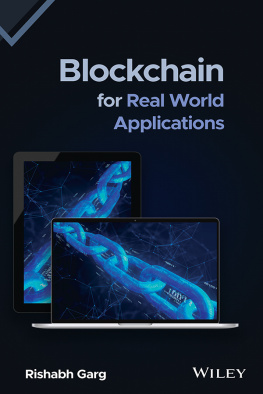
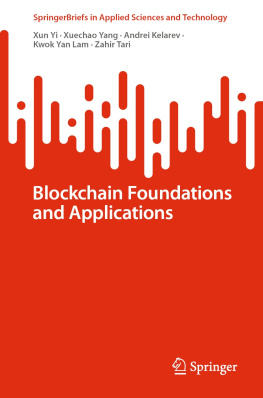

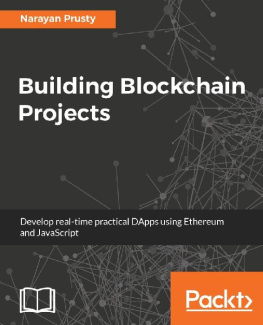
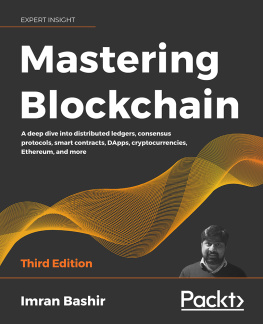
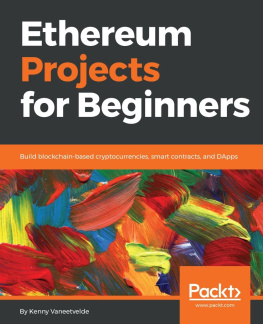
![Bellaj Badr [Bellaj Badr] - Blockchain By Example](/uploads/posts/book/119701/thumbs/bellaj-badr-bellaj-badr-blockchain-by-example.jpg)
